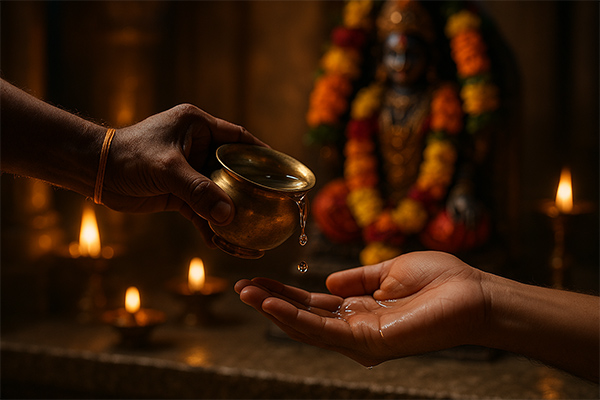
In every Hindu temple, there's a sacred moment when a devotee receives a few drops of Charanamrita; not just water, but divine nectar said to carry the blessings of the deity.
Literally meaning “nectar from the feet,” Charanamrita symbolizes the spiritual grace that flows from the feet of the Divine. It’s collected during rituals like Abhishekam (sacred bathing of the deity) and offered to devotees as a blessing believed to purify, protect, and deepen one’s devotion.
Whether in Vaishnava, Shaiva, or Shakta temples, this sacred offering transforms a ritual into a deeply personal connection with the Divine.
What Does Charanamrita Mean?
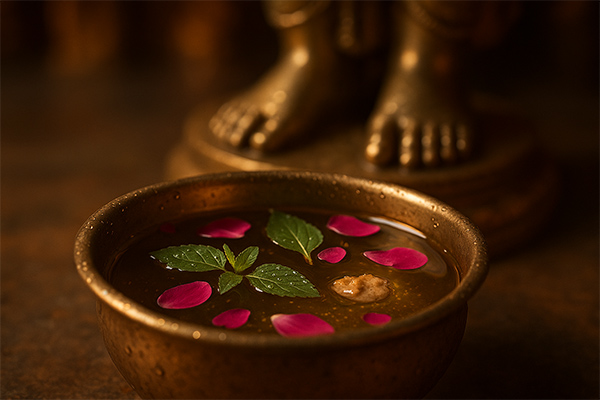
The word Charanamrita combines two Sanskrit terms: Charana (feet) and Amrita (immortal nectar). It refers to water that has touched the feet of a deity or saint and is offered as a sacred blessing.
In Hindu worship, the feet of the Divine represent the highest point of surrender. During rituals like Abhishekam, water and other sacred substances are poured over the deity’s feet. This sanctified water becomes Charanamrita. Energized by mantras and the presence of the deity.
More than symbolic, Charanamrita is believed to purify the mind, remove inner obstacles, and deepen one’s connection with the Divine. In Vaishnava and Shaiva traditions alike, it holds great spiritual power, mirroring the belief that the Ganga itself flowed from the feet of Lord Vishnu.
Why is Charanamrita Given in Temples?
Charanamrita is more than a tradition. It is the first tangible blessing a devotee receives after darshan. Offered from the Garbhagriha (sanctum sanctorum), where the deity is infused with divine life through Prana Pratishtha, it carries potent spiritual energy.
During Abhishekam, sacred substances like milk, honey, curd, ghee, and water are poured over the deity. As they flow over the feet, they absorb mantras, rituals, and divine vibrations, transforming into Charanamrita.
Drinking Charanamrita is believed to purify the mind and body, remove negative karma, and protect against inner and outer disturbances. It connects the devotee not only with the physical form of the deity but with the Shakti, the divine energy installed in the temple.
Received with reverence, it is sipped slowly, often touched to the crown, symbolizing surrender, protection, and spiritual alignment.
How is Charanamrita Prepared?
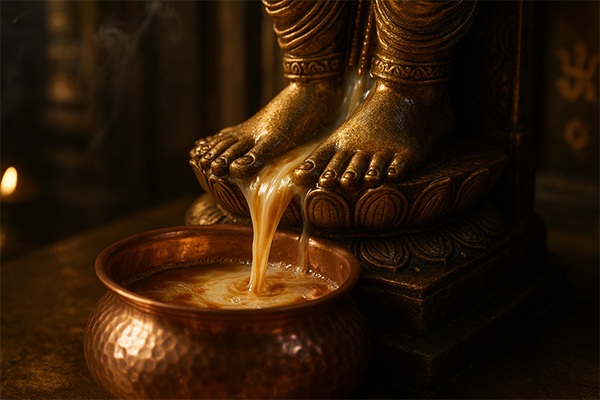
Charanamrita is prepared during Abhishekam, the ceremonial bathing of the deity using sacred substances like milk, honey, curd, ghee, water, and herbs. As these offerings flow over the feet of the deity, they are collected in a clean copper, silver, or brass vessel. This water, infused with mantras, devotion, and divine touch, becomes Charanamrita.
Its potency lies not just in the ingredients but in their contact with the feet of the deity residing in the sanctified Garbhagriha. The vibrations from Prana Pratishtha, daily worship, and chants further energize the Charanamrita, turning it into a medium of spiritual grace.
In some traditions, especially during major festivals or rituals, Charanamrita is also prepared by washing the feet of the deity or a living saint or guru. This stems from the belief that the lotus feet are the seat of divine energy. Water used in this act becomes highly sanctified and is offered to devotees as a powerful spiritual blessing.
Even washing the feet of a true devotee or guru and partaking that water is considered purifying, as illustrated in the Ramayana and Bhagavata Purana.
Charanamrita is always prepared fresh, handled with utmost sanctity, and consumed with devotion, never stored or treated casually.
Ingredients Commonly Used
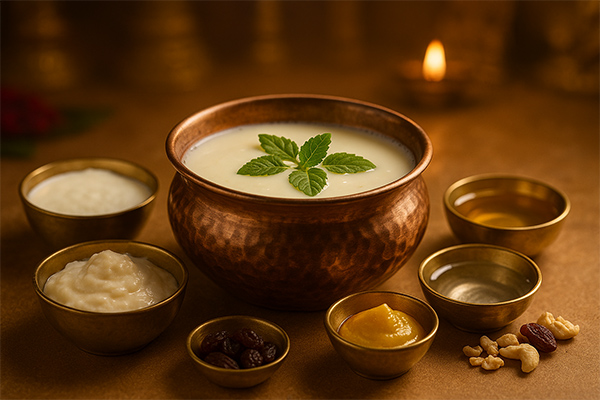
The ingredients used to prepare Charanamrita may vary by region or sampradaya, but traditionally include:
- Milk – representing purity and nourishment
- Curd – symbolic of prosperity and fertility
- Honey – for sweetness and divine union
- Ghee – for clarity, light, and sattvic energy
- Tulsi leaves – considered sacred and loved by Lord Vishnu
- Gangajal – holy water from the Ganga, used to sanctify any offering
- Dry fruits – such as raisins or crushed cashews, occasionally added for richness and as a mark of offering the best to the Divine
Each ingredient is symbolic and has a deeper spiritual meaning, contributing to the Charanamrita’s healing and transformative nature.
Charanamrita is always prepared in a clean vessel, ideally made of copper, silver, or brass, and is offered fresh after the puja. It is never stored casually, as it carries divine vibrations and should be consumed with reverence.
Scriptural References and Mentions
Across the Puranas, Itihasas, and Smritis, sanctified water from the feet of the Divine is portrayed as a powerful purifier and a direct channel of grace.
Vishnu Purana
During the Vamana Avatar, Bhagwan Vishnu pierced the universe with His toe. From this cosmic opening flowed the sacred waters of the Causal Ocean, which touched His feet and became the Ganga, Vishnupadi, “that which flows from Vishnu’s feet.”
Skanda Purana

The Skanda Purana repeatedly highlights the sanctity of water that touches the deity. It praises its purifying power and encourages its offering and consumption as a path to spiritual upliftment.
Ramayana

In a moving episode, the boatman Kevat washes Shri Ram’s feet before letting Him board his boat. He drinks that water with deep reverence, recognizing it as Charanamrita, an act of devotion and surrender.
Bhagavata Purana

Great sages are described as purifying themselves with water from the Lord’s feet. It is revered not merely as water, but as divine energy that dissolves ego and awakens inner clarity.
Padma Purana
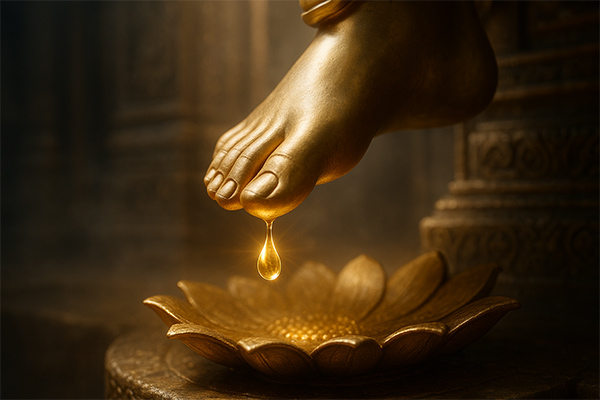
The Padma Purana declares that even a single drop of Charanamrita can cleanse all sins and lead to liberation. It is not just symbolic; it is a living stream of divine grace.
Across all these texts, one message is clear:
Water that touches the feet of the Lord is sacred, transformative, and capable of elevating the soul.
Can Charanamrita Be Taken at Home?
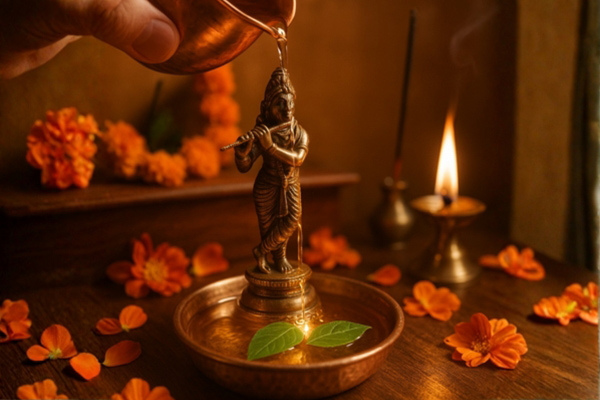
Yes. Charanamrita can be respectfully prepared and consumed at home, especially during daily puja, festivals, or personal rituals. While it is most commonly associated with temples, its sanctity lies in the devotion and purity with which it is made.
Your home altar is considered a miniature temple. When you perform Abhishekam on a deity’s murti,be it Shiva, Vishnu, Krishna, Lakshmi, or Durga, the water flowing over their feet becomes Charanamrita.
Different traditions follow this practice:
Vaishnavism:
After bathing idols of Vishnu, Krishna, or Rama, Charanamrita is offered with Tulsi leaves.
Shaivism:
Shiva is bathed with milk, honey, and water; Bilva leaves are added during Abhishekam.
Shakta tradition:
The Goddess is bathed during rituals like Navratri, and the collected water carries the energy of Shakti.
Even if you worship a photo or yantra, a few drops of water offered with mantra at the feet and received with faith is considered Charanamrita.
To preserve its sanctity:
- Use a clean copper or silver vessel
- Prepare it fresh and consume it right after puja
- Offer it with humility and devotion
- Avoid storing it or treating it casually
At home, Charanamrita becomes a simple yet powerful way to bring divine presence into your daily life.
How to Prepare Charanamrita at Home
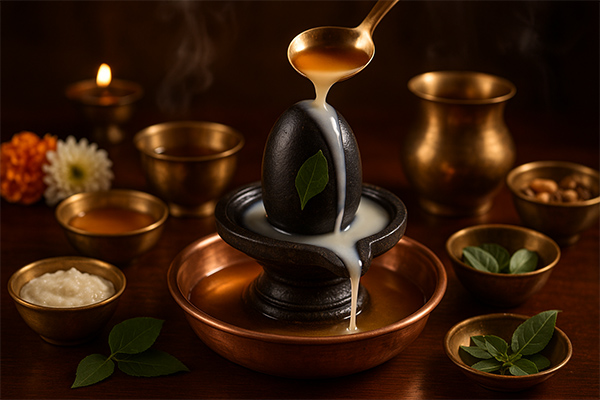
Preparing Charanamrita at home is simple yet spiritually powerful. You don’t need an elaborate setup, what matters most is purity, intention, and devotion.
Charanamrita is made during Abhishekam, where the deity (murti, Shaligram, Lingam, or even a photo or yantra) is bathed with sacred offerings. The water that flows over the deity’s feet becomes infused with divine energy and is collected with reverence.
Basic Ingredients (use all or a few based on your tradition):
- Fresh water (preferably Gangajal)
- Milk – purity
- Curd – nourishment
- Honey – sweetness
- Ghee – clarity and light
- Tulsi leaves – especially for Vishnu/Krishna puja
- Bel Patra – for Shiva worship
- Dry fruits (optional, like raisins or cashews)
Method:
- Clean the altar and your hands before starting.
- One by one, offer each ingredient over the deity, focusing on the feet.
- Chant the deity’s name or mantras while pouring the ingredients.
- Collect the mixture in a clean copper, brass, or silver vessel.
- After puja, stir the Charanamrita gently.
Distribute respectfully, sip with both hands and, if desired, touch it to your crown.
Always consume Charanamrita fresh, right after the ritual. Even a simple offering of water, when infused with mantra and faith, becomes Charanamrita when done with love.
Dos and Don’ts of Charanamrita Ritual
While Charanamrita is simple to prepare, it must be treated with the same care and reverence as any sacred offering. The way you handle, offer, and consume it reflects your inner bhakti and understanding of its divine nature.
Dos
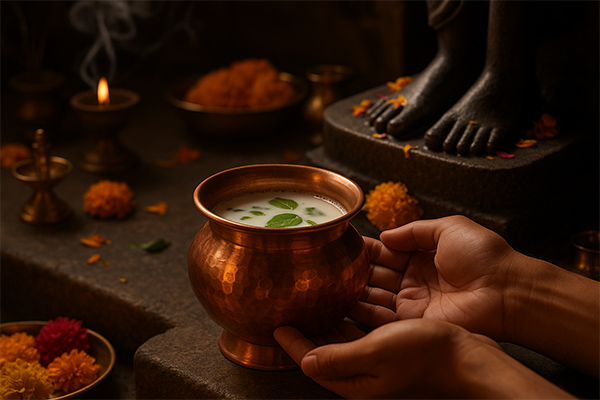
- Prepare it only after bathing and cleaning your altar space.
- Use clean, fresh, sattvic ingredients like milk, curd, honey, ghee, tulsi, and pure water.
- Use a pure vessel, traditionally copper, brass, or silver to collect and serve Charanamrita.
- Offer it first to the deity during Abhishekam or after placing it near their feet.
- Distribute Charanamrita respectfully, preferably after the completion of the puja.
- Consume it with both hands, with gratitude and a prayerful heart.
- If you’re unable to drink it, apply a drop to the crown of the head or eyes as a mark of devotion.
Don’ts
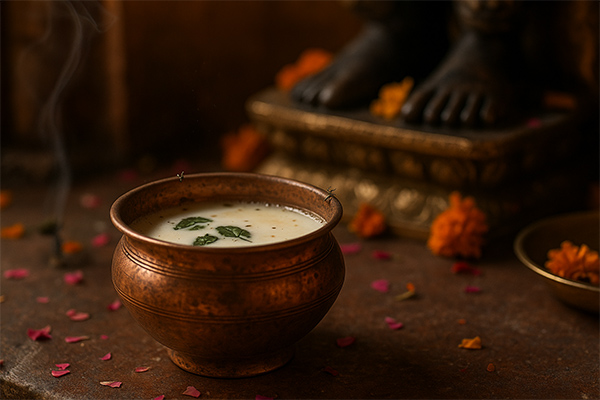
- Do not touch Charanamrita with unwashed hands or in a casual manner.
- Never store it for long durations. It is meant to be consumed fresh.
- Avoid using plastic or inappropriate materials for preparation or serving.
- Do not spill it on the floor or mix it with leftover food or water.
- Do not distribute it without offering it to the deity first.
Charanamrita is not just sanctified water. It is divine energy in liquid form; a sacred gift received with humility and devotion.


-in-Astrology.jpg)
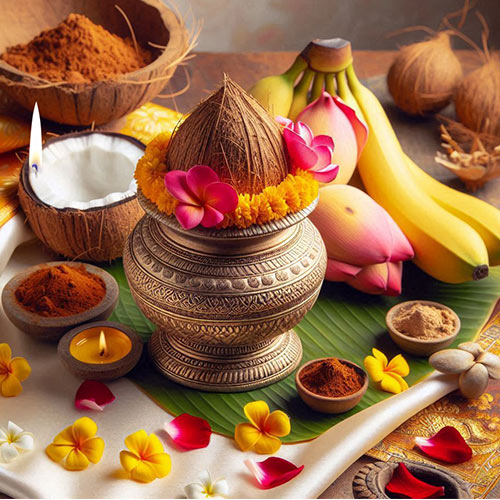


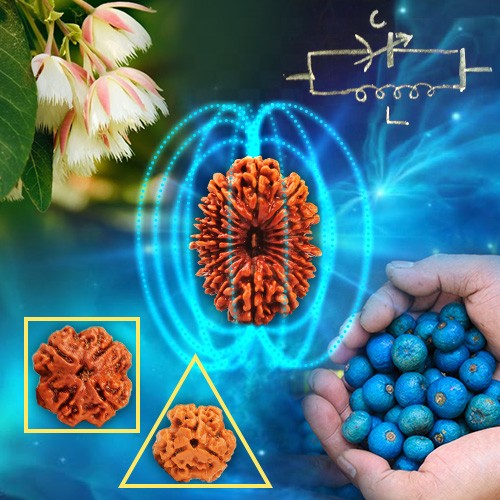

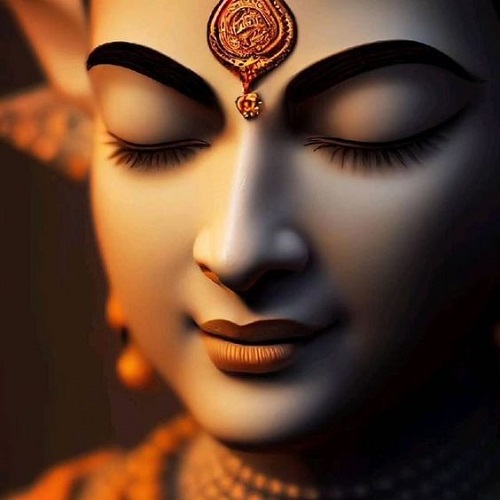
.jpg)
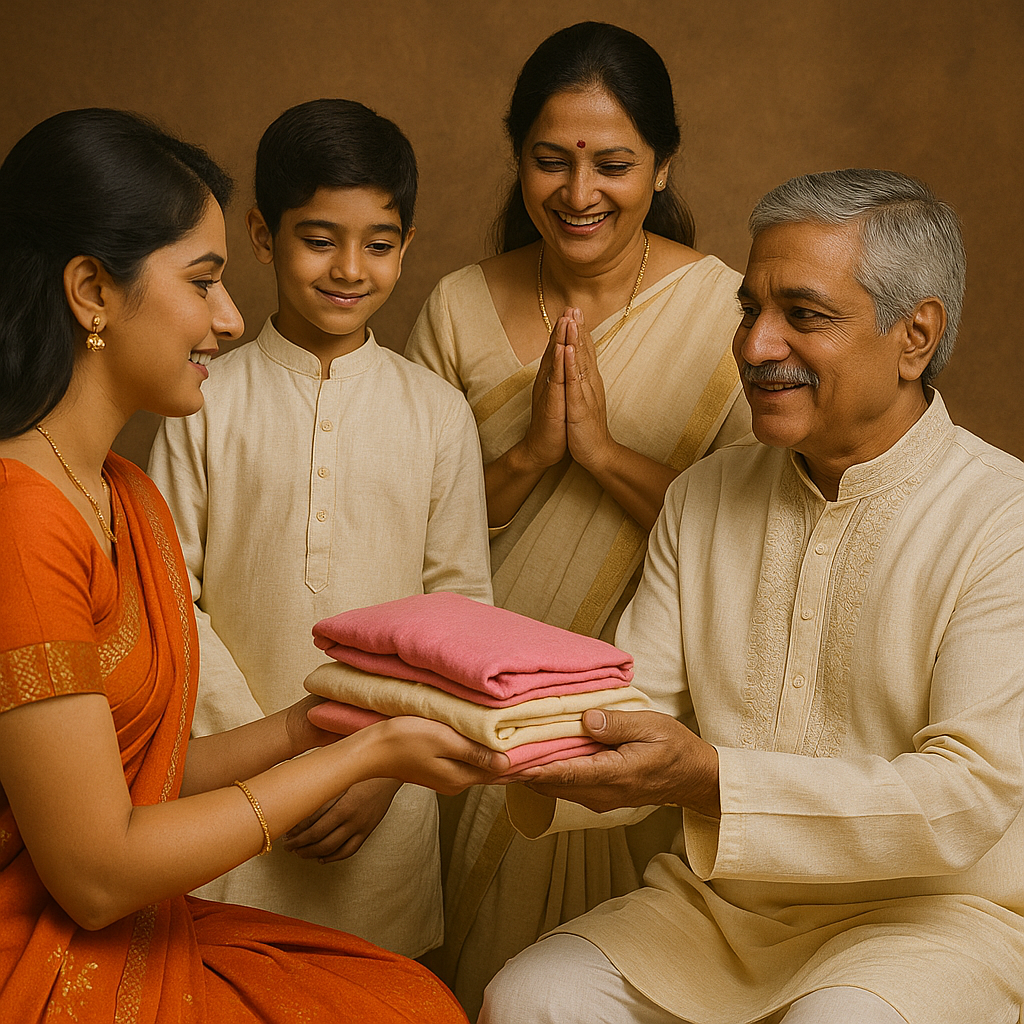
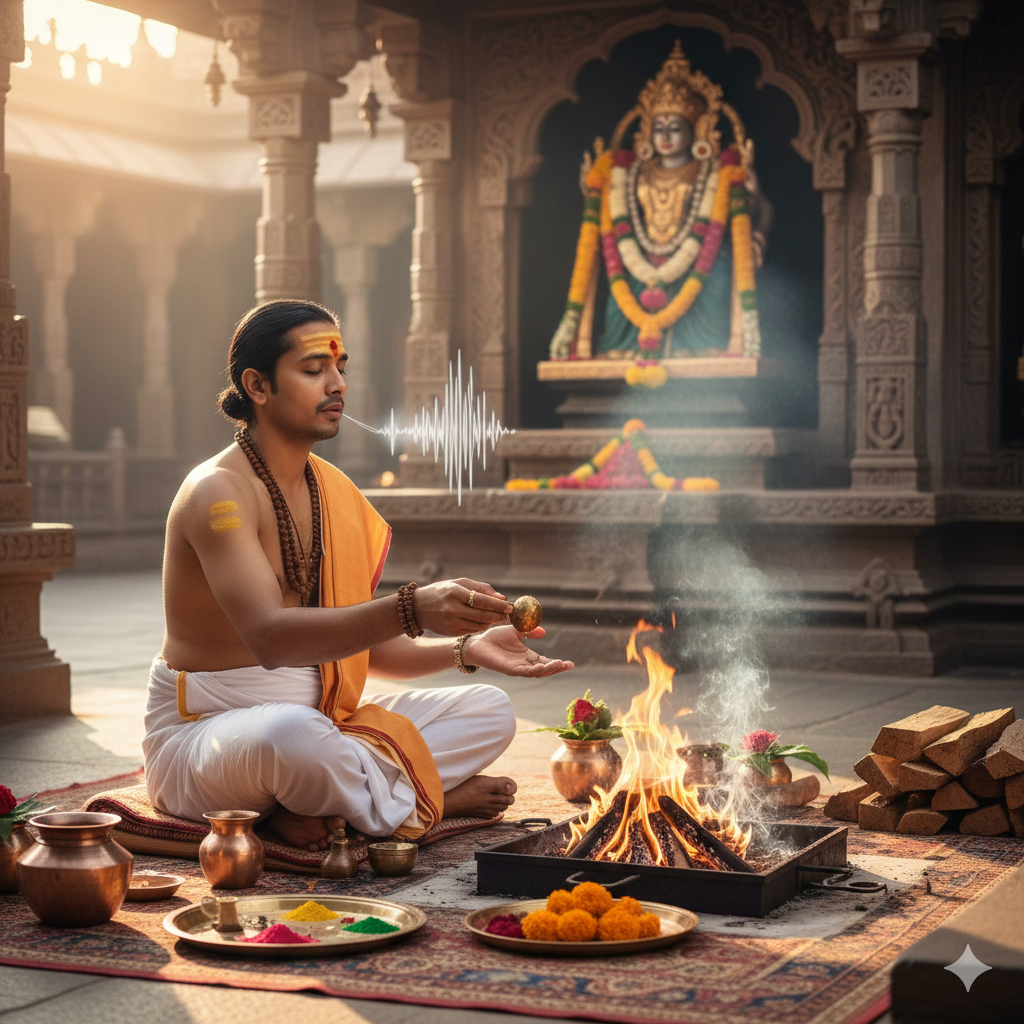

Comments 0
Leave your thought here